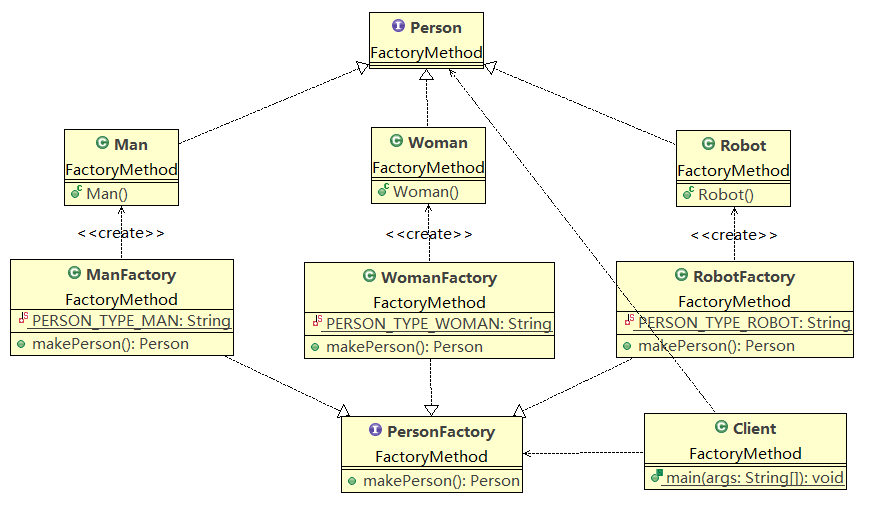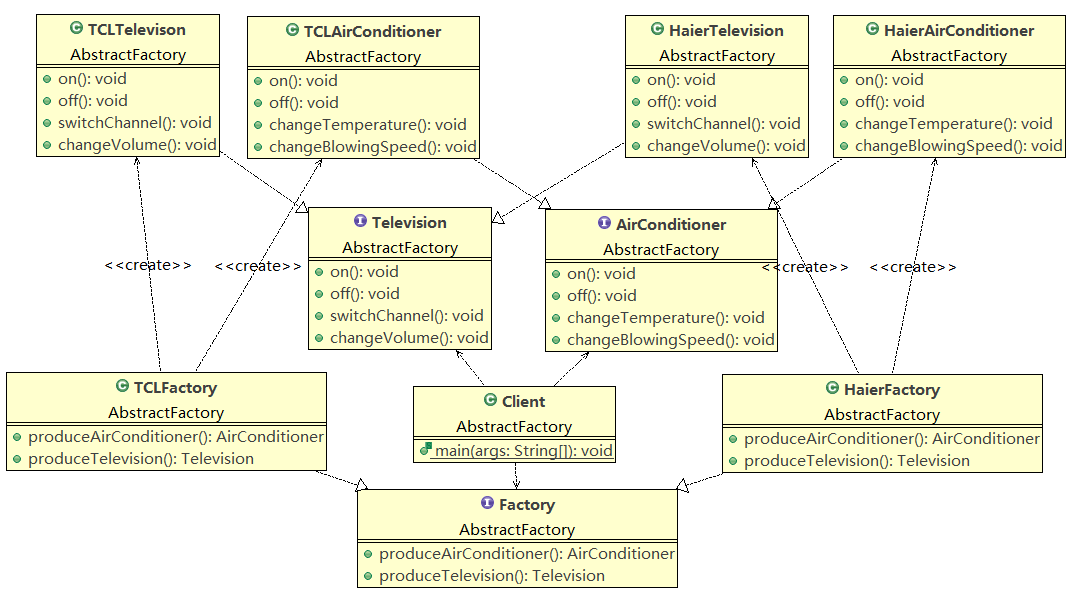简单工厂模式
案例
使用简单工厂模式模拟女娲(Nvwa)造人(Person),如果向造人的工厂方法传入参数”M“,则返回一个男人(Man)对象,如果传入参数”W“,则返回一个女人(Woman)对象,绘制相应的类图并使用 Java 语言模拟实现该场景。现需要增加一个新的机器人(Robot),如果传入参数为 “R”,则返回一个机器人对象,对代码进行修改并注意 “女娲 “类的变化。
抽象产品类
1
2
3
4
5
6
7
8
|
public interface Person {
}
|
具体产品
1
2
3
4
5
6
7
8
9
10
11
|
public class Man implements Person {
public Man() {
System.out.println("男人对象已创建!");
}
}
|
1
2
3
4
5
6
7
8
9
10
11
|
public class Woman implements Person {
public Woman() {
System.out.println("女人对象已创建!");
}
}
|
1
2
3
4
5
6
7
8
9
10
11
|
public class Robot implements Person {
public Robot() {
System.out.println("机器人对象已创建!");
}
}
|
工厂
1
2
3
4
5
6
7
8
9
10
11
12
13
14
15
16
17
18
19
20
21
22
23
24
25
|
public class Nvwa {
private static String PERSON_TYPE_MAN = "M";
private static String PERSON_TYPE_WOMAN = "W";
private static String PERSON_TYPE_ROBOT = "R";
public static Person makePerson(String type) {
if (PERSON_TYPE_MAN.equalsIgnoreCase(type)) {
System.out.println("返回一个男人对象!");
return new Man();
} else if (PERSON_TYPE_WOMAN.equalsIgnoreCase(type)) {
System.out.println("返回一个女人对象!");
return new Woman();
} else if (PERSON_TYPE_ROBOT.equalsIgnoreCase(type)) {
System.out.println("返回一个机器人对象!");
return new Robot();
}
return null;
}
}
|
客户端
1
2
3
4
5
6
7
8
9
10
11
12
13
14
15
16
17
18
19
20
|
public class Client {
public static void main(String[] args) {
Scanner sc = new Scanner(System.in);
String type = sc.next();
try {
Nvwa.makePerson(type);
} catch (Exception e) {
e.toString();
}
}
}
|
小结
角色
![]()
-
工厂 - Nvwa
-
抽象产品 - Person
-
具体产品 - Man、Woman 和 Robot
特点
-
工厂类包含必要的逻辑判断,以选择生产具体产品
-
用于单个产品生产
优点
缺点
适用环境
-
工厂类负责创建的对象比较少
-
客户端不关心对象创建的细节
工厂方法模式
案例
同上:使用简单工厂模式模拟女娲(Nvwa)造人(Person),如果向造人的工厂方法传入参数”M“,则返回一个男人(Man)对象,如果传入参数”W“,则返回一个女人(Woman)对象,绘制相应的类图并使用 Java 语言模拟实现该场景。现需要增加一个新的机器人(Robot),如果传入参数为 “R”,则返回一个机器人对象,对代码进行修改并注意 “女娲 “类的变化。
抽象产品类
1
2
3
4
5
6
7
8
|
public interface Person {
}
|
具体产品
1
2
3
4
5
6
7
8
9
10
11
|
public class Man implements Person {
public Man() {
System.out.println("男人对象已创建!");
}
}
|
1
2
3
4
5
6
7
8
9
10
11
|
public class Woman implements Person {
public Woman() {
System.out.println("女人对象已创建!");
}
}
|
1
2
3
4
5
6
7
8
9
10
11
|
public class Robot implements Person {
public Robot() {
System.out.println("机器人对象已创建!");
}
}
|
抽象工厂
1
2
3
4
5
6
7
8
9
10
11
12
|
public interface PersonFactory {
Person makePerson();
}
|
具体工厂
1
2
3
4
5
6
7
8
9
10
11
12
13
14
15
|
public class ManFactory implements PersonFactory {
private static String PERSON_TYPE_MAN = "M";
@Override
public Person makePerson() {
System.out.println("返回一个男人对象!");
return new Man();
}
}
|
1
2
3
4
5
6
7
8
9
10
11
12
13
14
15
|
public class WomanFactory implements PersonFactory {
private static String PERSON_TYPE_WOMAN = "W";
@Override
public Person makePerson() {
System.out.println("返回一个女人对象!");
return new Woman();
}
}
|
1
2
3
4
5
6
7
8
9
10
11
12
13
14
15
|
public class RobotFactory implements PersonFactory {
private static String PERSON_TYPE_ROBOT = "R";
@Override
public Person makePerson() {
System.out.println("返回一个机器人对象!");
return new Robot();
}
}
|
客户端
1
2
3
4
5
6
7
8
9
10
11
12
13
14
15
16
17
18
19
20
21
22
23
24
25
|
public class Client {
public static void main(String[] args) {
Scanner sc = new Scanner(System.in);
String type = sc.next();
PersonFactory factory = null;
switch (type) {
case "M": factory = new ManFactory(); break;
case "W": factory = new WomanFactory(); break;
case "R": factory = new RobotFactory(); break;
default:
System.out.println("输入有误!");
exit(0);
}
factory.makePerson();
}
}
|
小结
![]()
角色
特点
优点
缺点
-
系统中类的个数将成对增加,增加了系统的复杂度
-
增加了系统的抽象性
适用环境
-
抽象工厂类通过子类来指定创建对象
-
客户端不知道所需要对象的类
抽象工厂模式
案例
一个电器工厂可以产生多种类型的电器,如海尔工厂可以生产海尔电视机、海尔空调等,TCL 工厂可以生产 TCL 电视机、TCL 空调等,相同品牌的电器构成一个产品族,而相同类型的电器构成了一个产品等级结构,现使用抽象工厂模式模拟该场景。
抽象产品类
1
2
3
4
5
6
7
8
9
10
11
12
13
14
15
16
17
18
19
20
21
22
23
24
25
26
27
|
public interface AirConditioner {
public void on();
public void off();
public void changeTemperature();
public void changeBlowingSpeed();
}
|
1
2
3
4
5
6
7
8
9
10
11
12
13
14
15
16
17
18
19
20
21
22
23
24
25
26
27
|
public interface Television {
public void on();
public void off();
public void switchChannel();
public void changeVolume();
}
|
具体产品
1
2
3
4
5
6
7
8
9
10
11
12
13
14
15
16
17
18
19
20
21
22
23
24
25
26
27
|
public class HaierAirConditioner implements AirConditioner {
@Override
public void on() {
System.out.println("海尔空调已启动");
}
@Override
public void off() {
System.out.println("海尔空调已关闭");
}
@Override
public void changeTemperature() {
System.out.println("您正在使用海尔空调调节室温");
}
@Override
public void changeBlowingSpeed() {
System.out.println("您正在使用海尔空调调节风速");
}
}
|
1
2
3
4
5
6
7
8
9
10
11
12
13
14
15
16
17
18
19
20
21
22
23
24
25
26
27
|
public class HaierTelevision implements Television {
@Override
public void on() {
System.out.println("海尔电视已启动");
}
@Override
public void off() {
System.out.println("海尔电视已关闭");
}
@Override
public void switchChannel() {
System.out.println("您正在海尔电视切换频道");
}
@Override
public void changeVolume() {
System.out.println("您正在海尔电视调节音量");
}
}
|
1
2
3
4
5
6
7
8
9
10
11
12
13
14
15
16
17
18
19
20
21
22
23
24
25
26
27
|
public class TCLAirConditioner implements AirConditioner {
@Override
public void on() {
System.out.println("TCL空调已启动");
}
@Override
public void off() {
System.out.println("TCL空调已关闭");
}
@Override
public void changeTemperature() {
System.out.println("您正在使用TCL空调调节室温");
}
@Override
public void changeBlowingSpeed() {
System.out.println("您正在使用TCL空调调节风速");
}
}
|
1
2
3
4
5
6
7
8
9
10
11
12
13
14
15
16
17
18
19
20
21
22
23
24
25
26
27
|
public class TCLTelevison implements Television {
@Override
public void on() {
System.out.println("TCL电视已启动");
}
@Override
public void off() {
System.out.println("TCL电视已关闭");
}
@Override
public void switchChannel() {
System.out.println("您正在使用TCL电视切换频道");
}
@Override
public void changeVolume() {
System.out.println("您正在使用TCL电视调节音量");
}
}
|
抽象工厂
1
2
3
4
5
6
7
8
9
10
11
12
13
14
15
16
17
18
19
|
public interface Factory {
public AirConditioner produceAirConditioner();
public Television produceTelevision();
}
|
具体工厂
1
2
3
4
5
6
7
8
9
10
11
12
13
14
15
16
17
|
public class HaierFactory implements Factory {
@Override
public AirConditioner produceAirConditioner() {
return new HaierAirConditioner();
}
@Override
public Television produceTelevision() {
return new HaierTelevision();
}
}
|
1
2
3
4
5
6
7
8
9
10
11
12
13
14
15
16
17
|
public class TCLFactory implements Factory {
@Override
public AirConditioner produceAirConditioner() {
return new TCLAirConditioner();
}
@Override
public Television produceTelevision() {
return new TCLTelevison();
}
}
|
客户端
1
2
3
4
5
6
7
8
9
10
11
12
13
14
15
16
17
18
19
20
21
22
23
24
25
26
27
28
29
30
31
32
33
34
35
|
public class Client {
public static void main(String[] args) {
Factory factory = null;
AirConditioner airConditioner;
Television television;
try {
factory = (HaierFactory)XMLUtil.getBean();
} catch (Exception e) {
e.toString();
}
airConditioner = factory.produceAirConditioner();
television = factory.produceTelevision();
airConditioner.on();
airConditioner.changeTemperature();
airConditioner.changeBlowingSpeed();
airConditioner.off();
System.out.println("----------------------");
television.on();
television.switchChannel();
television.changeVolume();
television.off();
}
}
|
小结
![]()
角色
特点
优点
缺点
适用环境
-
每次只使用某一产品族
-
同产品族产品一起使用
-
产品等级结构稳定


